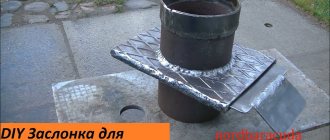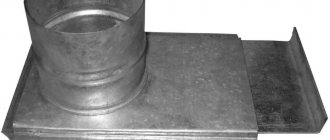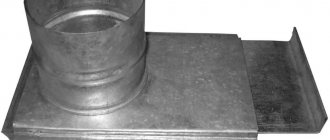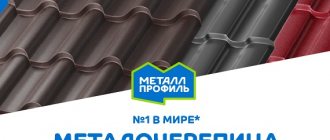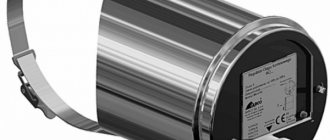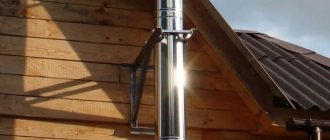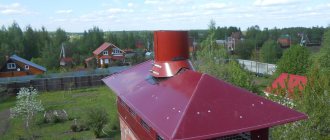- Cast iron
The functioning of stoves indoors or in a sauna directly depends on the installed chimney. From it, oxygen-saturated air is directed into the firebox, which is required to maintain stable combustion. The resulting smoke, soot and processed gases are removed from the room through a pipe. To regulate the combustion process and prevent heat loss, they resort to installing furnace rotary dampers for chimneys made of stainless steel and other materials.
What is it and what is it for?
Damper (from the German Schieber - damper) is a device for completely or partially blocking the movement of gases in the chimney. It has been used since the appearance of the first Russian stoves. Made from cast iron or steel. In modern engineering it has found application both in smoke exhaust structures and in ventilation systems.
Damper functions:
- Regulating draft and maintaining heat in the room.
The chimney is closed after use to prevent warm air from being drawn from the room into the chimney. Using a damper, you can reduce or increase the working cross-section of the chimney.
- Saving fuel consumption.
The valve can be used to regulate the intensity of oxygen flow to the flame, and accordingly increase or decrease the efficiency of the heater.
This statement is true only for furnaces and boilers without blowers and forced air supply devices.
How the gate works
Structurally, the gate is a locking device with an adjustable valve. It is thanks to the displacement of the valve that the movement of gases in the chimney is regulated. Can be installed in chimneys of round, square and rectangular cross-section. It is a metal plate that moves inside the smoke channel in a certain way.
Gate valves can be of two types:
- Retractable. Moves in one plane back and forth.
- Rotary. Regulates air access by rotating around its axis.
In addition, valves can be manual or equipped with an electric drive. The cost of the latter is an order of magnitude higher and they are not used in chimneys.
Functions, purpose and characteristics
The damper is a partition that is located inside the chimney. It follows the shape and area of its cross-section and, when closed, almost completely covers it. Changing the position of the damper allows you to increase or decrease the opening of the chimney pipe, increasing or decreasing the air flow. Using the damper, you can stop the movement of air after lighting the stove.
The gate valve is a thin metal plate that is manually adjusted using a special handle. The latter is located outside the chimney pipe so that the user can manually adjust the position of the plate.
Depending on the design and type of damper, it is installed using a special metal frame, or is inserted inside the pipe and fixed with an axial rod.
Important! Do not assume that the valve completely seals the pipe in the “closed” position. According to fire safety requirements, the damper must have a small hole through which weak gas exchange occurs.
The damper in the chimney performs the following functions:
- increases traction force in difficult weather conditions;
- increases the intensity of combustion in the furnace due to increased oxygen flow;
- reduces draft when there is a strong hum in the chimney during strong winds;
- saves fuel by reducing combustion intensity;
- prevents heat loss after the heater has warmed up.
Very important! You can close the chimney with a damper only after the wood has completely burned and the flame has gone out. If you close the damper prematurely, this can lead to a dangerous situation due to the release of large amounts of carbon monoxide into the room. If the damper is closed too late, the efficiency of the furnace will be reduced, because Most of the heat will go out through the chimney.
Basic Installation Recommendations
If the chimney is made of brick, then it is better to install the damper at a distance of one meter from the surface of the stove. This detail is installed at the stage of laying the fireplace itself. Only in this case can the damper frame be properly embedded. A small part of the gate assembly must remain outside. To prevent the novice technician from making mistakes, experts divided the installation process into several main stages:
- You need to start with laying the chimney (the first 7-9 rows).
- At this stage, the top layer of brick is covered with a small amount of mortar.
- Now you can safely place a pre-prepared frame, which should stand as straight as possible so as not to block the chimney.
- A layer of working mortar is applied to the installed product, and the masonry itself continues according to the existing scheme.
At the final stage, all that remains is to seal all existing cracks so as not to disturb the traction force and prevent carbon monoxide from entering the room.
Types of gate valves
There are two main types of gate valves - sliding and rotary (throttle). The design features are clear from the name: the first type works due to the perpendicular movement of the metal plate relative to the chimney pipe.
We recommend that you read: How to make a spark arrestor for a chimney with your own hands?
To increase draft, the damper is moved back and almost completely extends beyond the chimney, and to reduce the flow it is pushed back into the pipe.
Retractable gate
The most popular damper for a retractable type chimney. It compares favorably with other varieties in terms of reliability and ease of use. The retractable gate is a plate with a smooth, even surface, in which there is a special longitudinal hole. It runs along the grooves in the chimney.
This type of valve is installed strictly horizontally. To change the draft force in the chimney, it is enough to move the damper in the desired direction, increasing or, conversely, reducing the cross-section for the pipe.
This option is suitable for steel pipes, but is more suitable for stoves made of brick. Its installation does not require special knowledge or significant effort.
Some models provide a small cut-out area. This ensures the safety of the structure: even if this valve is completely closed, the movement of carbon monoxide in it will continue.
Rotary gate
Another type is a rotary gate. It is a plate made of metal, which is fixed in the central part of the guide by welding.
Dimensions and principle of operation of the rotary gate
Its main portion is located in the inside of the chimney, but the tip should always remain outside. Against the background of rotation of this plate relative to its own axis, the draft in the chimney is regulated.
The disadvantage of this type is the need for fastening by welding. It is this place that is the weak point of the design: the damper will open if the fastening becomes loose.
The rotary gate is characterized by low reliability. But this indicator may vary depending on what it is made from. Most often it is used for installation in steel chimneys. It is also installed in cases where there is not enough space to extend the classic valve.
Cast iron gate
Cast iron dampers have found quite wide application in various types of stoves and fireplaces. The disadvantage of such products is their significant mass. At the same time, cast iron itself has been used for a long time in the production of valves for furnaces. This is explained by its high reliability, durability and strength.
Model range of cast iron gates
Steel type gate
A gate unit made of stainless steel is not the cheapest option. But the design is characterized by high quality and excellent performance characteristics. Its advantages are as follows:
- maintaining furnace efficiency;
- small weight;
- long service life;
- not subject to metal corrosion;
- prevents soot accumulation.
These gates may have different designs depending on the characteristics of the furnace. They are relevant for chimneys made of steel or brick.
We recommend: Gas double-circuit boiler: what is it, single-circuit or double-circuit, with a boiler
Safety precautions
When talking about gate valves, first of all we should focus on safety precautions. Already from the definition it becomes clear that this device is capable of completely blocking the natural flow of air from the room through the stove and chimney to the street. The oven can be in such a locked state only under one condition - there is nothing in it that is still smoldering even a little, much less burning.
As you know, burning wood in a stove leads to the release of carbon monoxide, which is poisonous to humans. The danger of poisoning with this gas is that a person may simply not feel the harmful effects of the gas until he begins to lose consciousness, and then it may be too late. This danger should not be underestimated: for example, it is known that the famous French writer Emile Zola died in Paris in his bedroom from carbon monoxide.
We recommend a video review of the features of gate valves of various designs.
An attentive reader may notice that valve manufacturers produce them with special holes that prevent complete blocking of the chimney. However, with regular use over time, soot and resin accumulate on these holes, which gradually reduce their throughput, and then can completely block them. Obviously, the chimney periodically needs to be cleaned and the damper is no exception, but in practice this procedure is carried out much less frequently than required by safety regulations.
Principle of operation
When the plate moves inside the device, the channel capacity decreases or increases. The further the damper in the pipe is moved, the sooner the smoke is removed and the combustion of the fuel in the stove accelerates. Completely blocking the hole in the chimney allows the heat to remain in the stove and work to heat the room air throughout the day.
The plate can be completely retracted only in a heated hearth, when substances harmful to human health cease to be released. If the valve is closed too early, there is a risk of suffocation among family members. Sometimes failure to comply with this rule leads to the death of people.
Boiler models are produced with built-in baffles, so installation of a damper is not necessary. Other heating units, furnaces, boilers require the installation of a valve. It is installed in ventilation and exhaust pipes.
Chimney deflector (Photo: Instagram / deflector21)
Differences between retractable and rotary gates
So far we have been talking about the retractable type of damper on a stove chimney, although there is another type - a rotary one. Let's look at how they differ.
The purpose of both types is the same - to partially or completely block the flow of flue/heated gases. The differences relate to the design.
A retractable model is a metal plate that is fixed in a frame and moves along guides in a horizontal position. There are no strict requirements for the dimensions of the device, since they must correspond to the cross-section of the chimney and completely depend on its parameters.
Thus, the valve consists of two main parts:
- frame , which is fixed in the smoke exhaust duct and is motionless;
- plate moving inside the frame.
Typically, both parts are made from the same material to maintain performance when heated or cooled.
A properly designed and installed damper should never completely block a stove chimney. A small gap is necessary for fire safety purposes.
The design of the rotary (throttle) gate does not extend, but rotates along an axis, as the name suggests.
A round or rectangular plate (depending on the cross-section of the chimney) is fixed on a metal rod, the free end of which extends beyond the channel and serves as an adjustment tool.
The simplest model of a rotary gate with a diameter of 120 mm. Manufacturing material – stainless steel. The smoke exhaust channel is closed by turning the handle with a curved end
Gate valves are considered more reliable and wear-resistant devices. The weak point of the rotary devices is the connection between the rod and the plate, which becomes loose over time and renders the valve unusable.
Types and designs
The chimney damper is available in several versions.
Retractable
It is a round or rectangular frame with a plate. The plate extends and retracts, thereby adjusting the cross-section of the chimney.
This option is most often used with brick and ceramic channels. To ensure incomplete sealing and avoid carbon monoxide poisoning, a small hole is made in the plate. The main advantage of this option is ease of installation.
Rotary throttle
A rotary or throttle valve (also known as a hog valve) is a plate made of steel or cast iron that rotates around an axis. The axis is a metal rod welded inside the chimney. Used in steel chimneys.
It is less reliable - over time, the welding fastening of the plate and axle weakens. You should avoid installing a rotary damper in the bathhouse - even when closed, this type of damper partially allows steam to pass through.
In addition, gate valves differ in material (the most common are stainless steel and cast iron) and the method of adjustment.
Differences between retractable and rotary gates
The retractable damper allows you to adjust the working cross-section of the chimney, while the rotary damper only allows you to open or close the pipe. Of course, some tricks are possible - such as securing the hog in an intermediate position in different ways, but the factory equipment does not provide for this. In addition, the rotary gate complicates mechanical cleaning of the pipe.
The hog is often installed in metal chimneys, and the retractable one is installed in brick chimneys.
Which material is stronger
In addition to structural differences, types of gate valves may differ in the material of manufacture. The only possible option is metal, since it is the only one that does not burn or deform at high temperatures, and over time, even in an aggressive environment, does not change its characteristics.
For production, either cast iron or stainless steel is used. It is not possible to build a damper from cast iron yourself, since this requires, at a minimum, a forge. However, you can find both nondescript and beautifully designed cast iron dampers on sale.
Cast iron rotary gate with a comfortable handle. This design is suitable for a brick chimney with a rectangular cross-section, capable of supporting the fairly heavy weight of the device
Steel products look simpler, but their characteristics are similar to their cast iron counterparts. The advantage of steel fixtures is their light weight.
If a cast iron damper for a stove chimney is installed only on a durable, permanent structure, then a steel damper is suitable for any smoke exhaust ducts - brick and steel, rectangular and round, solid and light.
Samples of a galvanized steel damper, chimney cross-sectional diameter – 150 mm. Galvanization, unlike ordinary steel, does not react to moisture (condensation) and does not corrode
When choosing a material, you need to focus on the characteristics of the chimney pipe and the features of the interior.
For a country heating stove, a modest steel valve is sufficient, while for upgrading a Russian stove in a cottage, a custom-made cast iron valve is better suited.
Selecting a location option
There are three main options for placing the damper in the chimney:
- pipe-to-pipe fastening;
- placement in a fireplace insert;
- installation in a ventilation pipe.
Brick chimney with damper
If you place a gate valve in the outlet pipe or in the furnace firebox, that is, build this element into its design, the damper is placed on a section of pipe as close as possible to the heating boiler. This guarantees ease of control and ease of turning the valve. This is explained by the fact that the handle will not touch either the portal or the cladding area. If it is located according to the “pipe to pipe” option, no additional fastenings are required for connection with other elements of the furnace.
If you place the damper assembly in a pipe intended for ventilation, overheating of the fan motor during its operation is prevented.
Typically, ready-to-install chimneys are offered, which are equipped with everything necessary, including a slide valve. In this case, it is placed in the system in accordance with the manufacturer's instructions. If it is not provided for one reason or another, it is quite possible to manufacture and install this element yourself.
Expert advice
Where to install the damper on the chimney
There are 3 options for placing the damper relative to the chimney:
- Placement in the firebox of a fireplace or stove;
- Fastening according to the “pipe to pipe” principle;
- Installation in a ventilation pipe.
Let's consider the first 2 options:
- By placing the valve in the furnace firebox or in the outlet pipe
In this case, the damper is located at a height of no more than 1 m from the firebox, on an uninsulated section of the pipe. This location is convenient for adjusting the damper.
- Pipe in pipe
Applicable for metal chimneys. This installation option does not require additional fasteners. When purchasing a ready-made system, you should install the valve strictly according to the manufacturer’s instructions.
How to adjust traction
Adjusting the draft using a slider is quite simple. By changing the position towards increasing the gap, we increase the flow of air to the fire and the flame flares up stronger. Reduce the gap - traction decreases. The valve is closed after the flame has completely died out - this way the oven cools down much faster.
The latest boiler models are made with built-in automatic baffles. All other heating units require the mandatory installation of a damper.
Tips for choosing a gate valve
It must be remembered that the correct selection of an element such as a slide damper is reflected in the future not only on the draft indicator, but also on the safety of the heating system, of which the chimney is a part. Installation of the damper is carried out on any model of fireplaces and stoves, except for the most modern ones, which have a deflector.
We recommend: Stove for the garage: how to make a stove with your own hands, homemade designs for long-term burning using waste and wood
The main recommendations for choosing slide valves for smoke exhaust communications are as follows:
- If the heating device operates by processing gas, it is better to purchase a rotary valve model. This is due to the fact that such models exclude the possibility of completely blocking the smoke exhaust channel. Thus, the heating system will be safer. The chimney, which removes combustion products from the gas stove, must be closed by at least 40 percent during operation;
- There are heating systems that operate intermittently (periodic). A closed damper installed in such a heating structure, as a rule, allows steam to pass during supply, and an open damper contributes to the formation of a large amount of soot on the pipe, which is located below the plate;
- It is strictly not recommended to use rotating elements for installation in sauna chimneys.
A rotating device is the most suitable option for a gas-consuming system
Note! The chimney damper is a shaped part of the chimney service, so if you purchase everything necessary for laying a chimney, it will be included with the pipes. Such shutters can be purchased at any specialized store or ordered using an online store on the Internet.
Experts recommend carefully measuring the cross-section of the smoke exhaust duct before purchasing a gate product. Perhaps this is the main thing that needs to be done before purchasing a gate.
Functionality
Since the damper is the main regulator of draft inside the house, the intensity of fuel combustion depends on it. To reduce the draft and intensity of the flame in the firebox, you just need to close the damper. To increase the fire, the opposite actions are carried out.
Modern damper models can be installed in both single-wall and double-wall boilers. If the fireplace or stove is not in use, then at this time the rotary damper valve for the chimney must be completely closed. Most often, craftsmen install a damper on the first meter of the chimney, since this area is not insulated. A different situation occurs with well-insulated pipes, since they should not have valves. The main danger is that when the internal and external metal expands, the gate may simply jam.
This device regulates traction
The main functionality of the damper includes:
- Partial blocking of the chimney duct.
- High-quality traction control.
- Control over the intensity of flame burning in the firebox.
Features of installation of gate valves
To install the throttle valve, it is necessary to make markings on the pipe in order to drill holes according to the welded valve structure.
To do this, you need to measure the pipe using a measuring tape and make marks for future holes. After making sure that the marks are symmetrical, use a drill to drill holes for the future rotary handle.
The throttle valve is installed as follows:
- A steel damper circle with a welded tube is inserted into the chimney pipe.
- A metal rod is threaded through the drilled holes in the pipe through a small tube, the end of which is secured with a bolt and nut.
- The end of the rod is bent using pliers for a rotary handle.
Important! It is advisable to install a wooden element at the end of the rod, which will serve not only as decoration, but also as protection from touching hot metal, since the damper will become very hot during operation.
Next, you can install the resulting structure in the chimney pipe. To do this, the first piece of pipe is put on the furnace pipe of the stove heating, onto which a structure with a gate valve is installed on top. The next piece of metal pipe is put on the gate. All connections are treated with liquid silicone sealant.
Installation of a retractable damper in a brick chimney occurs during the masonry process. To do this, after 6-8 rows of bricks, a layer of cement masonry mortar is applied, on which a wire frame is installed with the open side facing the performer. You need to insert a latch into the frame and bring it into the closed state.
The frame is covered with mortar on top and bricks continue to be laid according to the standard pattern.
Attention! The slide damper is allowed to be installed in the first section of the chimney, at a height of up to 1 m above the firebox. This will ensure ease of adjustment of the damper and good aerodynamic properties of the chimney.
DIY making
The simplicity of the design of the damper plate for the chimney allows you to make it yourself to ensure further regulation of the draft in it.
Option 1. Manufacturing a rotary gate from stainless steel
We offer detailed instructions for manufacturing the damper already with a finished stove heating, when the design is completed, but the damper mechanism was not provided.
To make and install a gate valve with your own hands, you will need the following materials:
- grinder, cutting and grinding abrasive wheel;
- drill;
- tap;
- oil for lubricating the tap when cutting threads;
- hammer;
- vice;
- pliers;
- welding;
- core;
- electrodes for stainless steel;
- compass;
- roulette;
- permanent marker.
The materials you should immediately prepare are:
- stainless steel sheet 1.5 -2 mm thick.
- stainless steel tube with an internal diameter of 6 mm;
- 2 bolts 8mm,
- nail (or metal rod).
When all the tools and materials are prepared, you can begin to carry out the work.
- Measure the inside diameter of the pipe and mark it on the stainless steel sheet using a compass.
step 1 - Now, using a grinder, cut out a circle according to the markings made.
Step 2 - We try on the cut-out damper and, if necessary, modify it with a grinding wheel until it clearly fits into the pipe.
Trying on the damper - Take the prepared stainless steel tube and apply it to the finished circle. Use a marker to measure the size of the flap. We make it smaller than the internal diameter by 3 mm on each side.
Step 4 - We cut the pipe with a grinder and a cutting wheel.
- We drill an internal hole in the 6.8 mm tube for threading. When drilling, it is necessary to periodically lubricate the inner surface of the tube with machine oil.
Drilling out the tube - We cut an 8mm thread on both sides of the tube with a tap, not forgetting to lubricate the tap in the process. To remove the cutting chips, it is necessary to make a half turn back every half turn of the tap along the thread.
Step 5 - Now you need to make three holes in the damper. Immediately use a marker to make marks.
- Clamp the tube and the valve in a clamp and weld the tube to the valve through these holes (welded rivets). We start welding from the central hole, then release any one clamp and weld it into the free hole.
Step 6 - We mark the future holes on the smoker. To ensure that the axis of the holes clearly coincides, wrap the pipe with a tape measure and measure the center horizontally and vertically. Let's drill.
Making the markings - We assemble the damper into a tube.
Step 7 - Making a template for the damper clamp.
Step 8 - We transfer the markings to the metal sheet. You can use a compass.
Step 9 - Mark the middle for the fastener holes, cut and drill according to the markings.
- We weld it to the pipe.
We weld the clamp
Option 2. Manufacturing a horizontal sliding gate from stainless steel
For this option, you need to purchase a ready-made factory stainless steel gate valve. The design represents a frame within which the mechanism moves.
- Lay out 2 rows of the stove or fireplace according to the ordering pattern used.
horizontal sliding gate - On the row where the valve will be installed, we cut grooves in the brick. These are small grooves into which the metal element will fit. It is best to use an angle grinder with a wheel for this work. But if you don’t have such a professional tool, then you can get by with a file.
- The damper is installed.
- It is necessary to cut a recess in the side brick for the movement of the damper handle, because it will need to be cleaned of soot during operation.
We block the gate with a row of bricks - The next row of bricks is laid and all the resulting gaps are well sealed.
We recommend: Why do we need a heat exchanger in a heating system?
As you can see, making a gate does not require much time or much experience. At the same time, this is a very important detail that will significantly increase the efficiency of the boiler or fireplace.
Gate manufacturing process
You can make both a rotating device and a retractable one on your own. To do this, you need to be able to use a grinder along with a welding machine. The main condition is to correctly take accurate measurements.
The valve should not fit tightly into the hole, as during high temperatures it can get stuck. If there is an excessively large gap, traction adjustment becomes significantly more difficult.
To make a sliding device, measure the cross-section of the pipe from the inside, and then cut the sliding device from a steel sheet, the thickness of which is from four to five millimeters.
The shape is rectangular. A one-sided fold is performed, the dimensions of which correspond to twenty to thirty centimeters. This ensures comfortable extension. The cuts are polished on all sides.
- For a steel rectangular chimney, the strip should be two millimeters thick and thirty to thirty-five millimeters wide.
- After bending the strip, the gap should remain two millimeters. Cuts at an angle of forty-five degrees are made in two places so that the result is a P shape. After which they must be welded end to end.
- You will need a couple of pieces of metal to connect the ends of the profile. The valve must move freely between them. The dimensions of the internal perimeter of the frame must correspond to the cross-section of the chimney.
If the chimney device is round in shape, then a pair of identical steel sheets will be required. Their thickness should be two millimeters. The holes are made in the central part and should be equal to the diameter of the pipe.
The sliding plate is cut separately. Using a welding machine around the perimeter on three sides, they must be connected. There should be a distance of five millimeters between the sheets.
Pipe installation
A gate valve can also be installed on a pipe. To do this, select a section of it where there is no insulation, otherwise it simply jams due to expansion as the element heats up. Experts recommend placing it about 1 meter short of the firebox.
The following procedure is suggested:
- Fastening the first part to the pipe with coating of the joints with a sealant characterized by heat-resistant properties.
- Installation of the gate on this segment or on the tee.
- Placement of the second trim for the pipe, which will connect the structure with the insulated sections of the chimney.
Due to the tight fit of all elements of this design, no additional fastenings are required. The installation technique is suitable for rotary and retractable gates. Sometimes a rotation limiter is additionally provided.
Installing a gate valve on a pipe
How does the installation work?
The rotary damper for the chimney is installed as follows. The height of the product is determined by the craftsman based on the actual structure of the furnace. The minimum height is 0.9-1 meters from the floor, and the maximum is approximately 2 meters. As a rule, installation does not take more time and proceeds in several successive stages:
- Selecting the installation location and setting marks on the bricks that need to be trimmed.
- Cutting bricks using a grinder.
- Fixing the chimney partition with masonry mortar.
- Brickwork according to a row pattern.
Installing a damper on a chimney
Today, there are two main ways to install a damper on a chimney:
- Installation in a fireplace insert. This installation option implies the location of the gate product in close proximity to the heating equipment. As a rule, in this case the distance from the damper to the heating apparatus is 1 meter. This arrangement is very convenient for regulating the valve.
- Connection with other elements of the heating system. In this case, there is no need to use additional locking elements, so this option is quite common. This type of installation can also be called “pipe to pipe”.
Helpful information! In addition, it is worth noting that the gate product can also be installed in the ventilation system. A gate valve for ventilation is necessary to prevent the fan motor from overheating. The fan motor may overheat during shutdown.
The above options for using valves for chimneys and ventilation systems are used everywhere. It is worth noting that today you can find a huge variety of stoves and fireplaces, which differ from each other from a constructive point of view. This variety of heating devices also influenced the range of gate valves. Therefore, the choice of a damper for a chimney depends entirely on the characteristics of the heating device and the chimney design in a particular case.
Advantages and disadvantages
Like any engineering solution, a gate has a number of advantages and disadvantages.
Pros:
- Possibility of traction control;
- Fuel economy;
- Dampers help retain heat.
Minuses:
- The devices make it difficult to clean chimneys;
- If installed incorrectly, the gate may jam and negatively affect the movement of gases;
- To make the correct adjustment, you must have some knowledge in the field of smoke exhaust systems.
Visual demonstration of the efficiency of a gate valve (video)
Closed gate:
Open gate:
In most cases, the gate is made of stainless steel with a thickness of no more than 1 mm. This part can withstand temperatures up to 9000C, is resistant to corrosion and has a low coefficient of thermal expansion.
In order to ensure maximum ease of operation of the chimney and good soot removal, the surface of the damper must be polished.
The joints are joined using the rolling method.
A standard damper covers up to 85% of the chimney, which is the optimal indicator for the effective removal of combustion products.
Gate for ventilation system
Dampers designed for ventilation consist of a damper in a metal pocket. These structures are used to block a section of the air duct from the network.
The standard damper for ventilation has a nipple connection. The longitudinal size of the product up to the nipple grooves can vary from 70 to 200 mm. If the installation is carried out on round air ducts of impressive diameters, then guide angles are additionally used, which ensure good movement of the damper. Round gate valves can be based on stainless, galvanized or black steel. The thickness does not exceed 1 mm.
Frequent errors and problems during installation
- Installation of a valve in an insulated area. Under the influence of thermal expansion, the damper may jam;
- Installation of a cast iron part in a metal chimney (cast iron weighs a lot);
- Using too thin steel or stainless steel with a low nickel content for the manufacture of valves. Such a product quickly deforms under the influence of hot gases and can burn out;
- Installation of a gate with a non-smooth surface;
- Installation of a valve without a hole for carbon monoxide release;
- Installation of handles that do not allow monitoring the position of the valve (applies to rotary elements).
Slider lever position
When the fireplace is operating, the damper is either half-open or open. The gate is completely covered (the closed position is the rotary valve plate across the channel) when trying to switch the fireplace to a slow combustion state (But fireboxes that have a gate are not always suitable for operating in this mode!). In some models of fireboxes, the damper is designed to fully open before opening the door (mechanical locking). And even in the “closed” position of the fireplace damper, there is a movement of flue gases and air through the channel (the system is determined by the standards, which is why manufacturers of fireplace inserts and chimneys initially make a loose damper).
Features of gate maintenance
The gate, made of stainless steel, is usually polished to perfect smoothness. Soot settles on it poorly, but still settles. Therefore, it must be cleaned periodically.
The horizontal valve can be cleaned simply by pulling it out to the maximum and applying a special solution. Rotary - cleaned through the chimney with a special plastic brush. You should also ensure that the damper moves freely along the guides. It is allowed to periodically lubricate them with an anti-corrosion compound.
